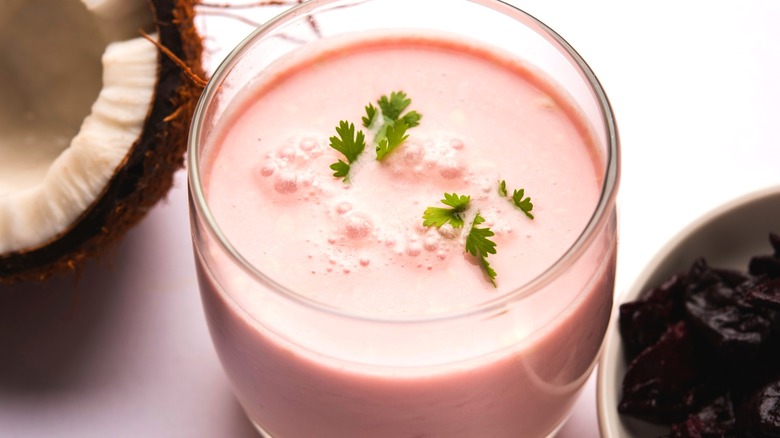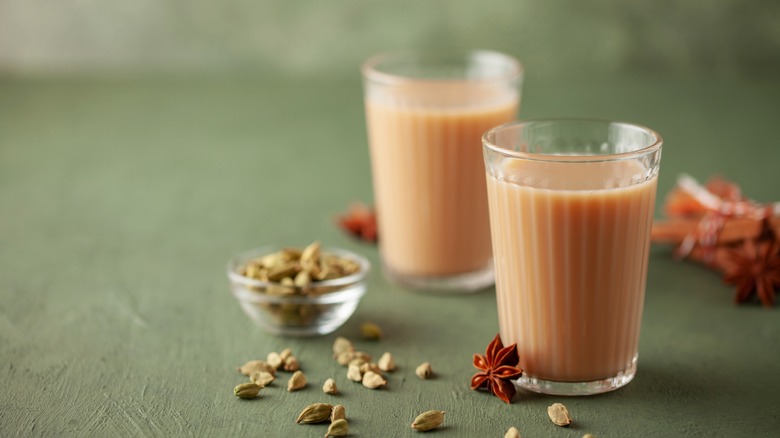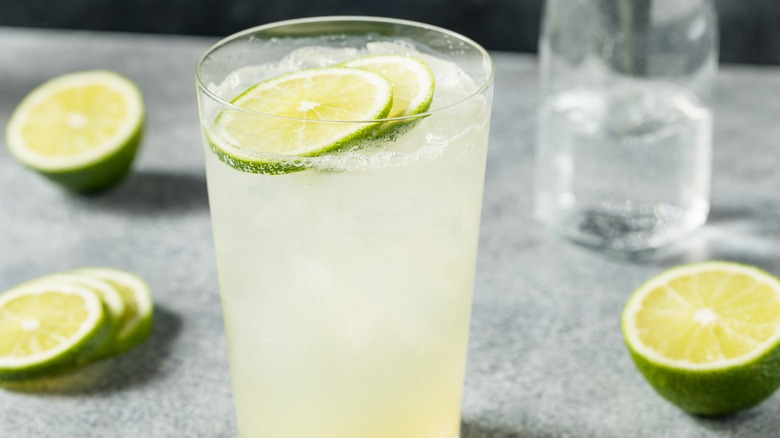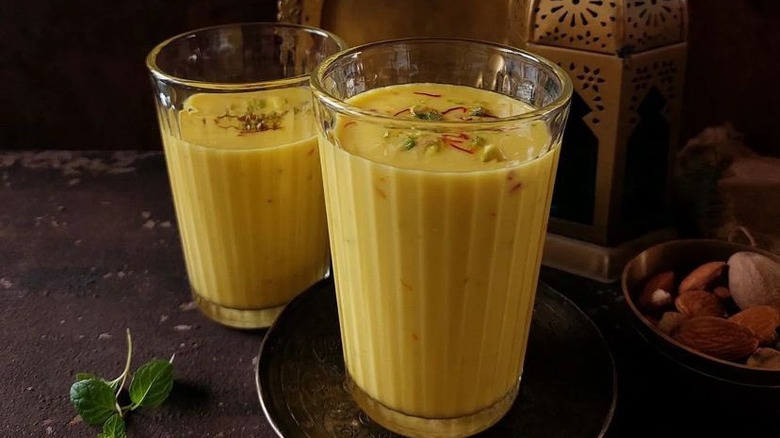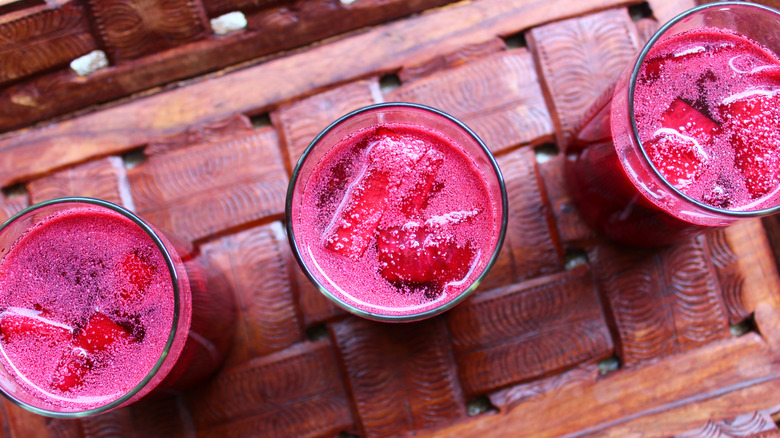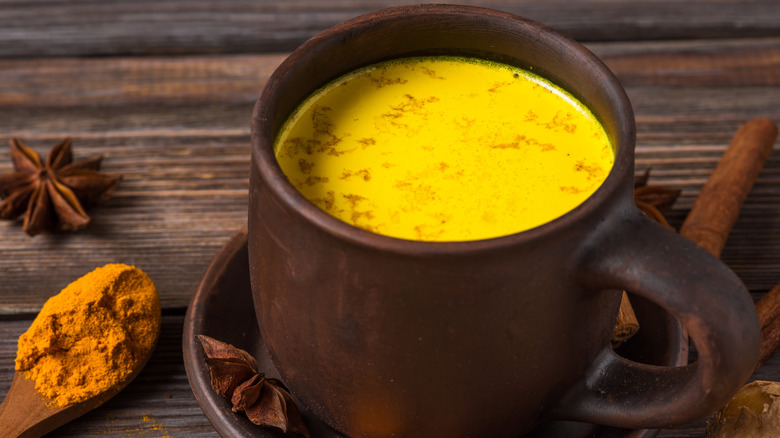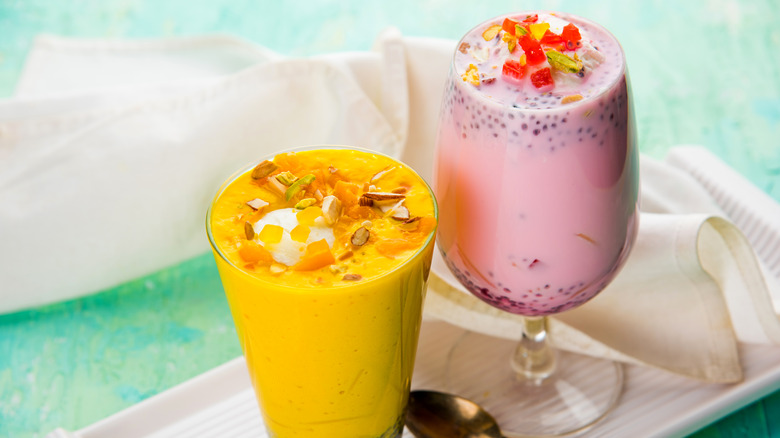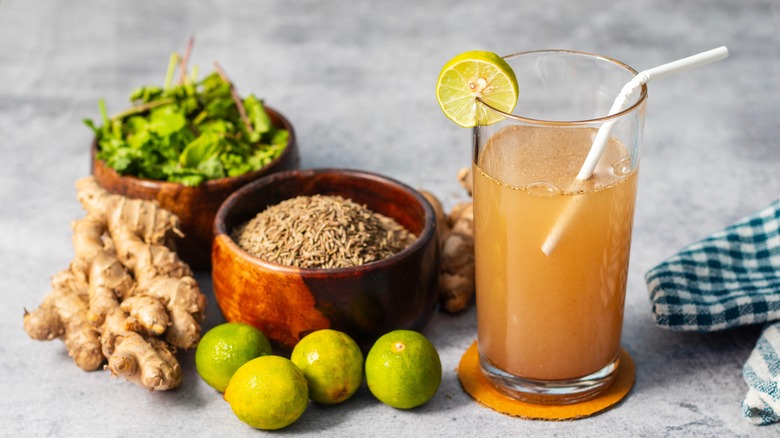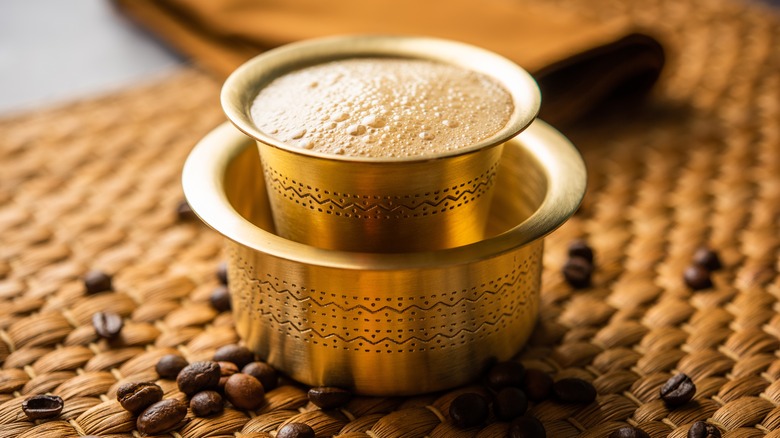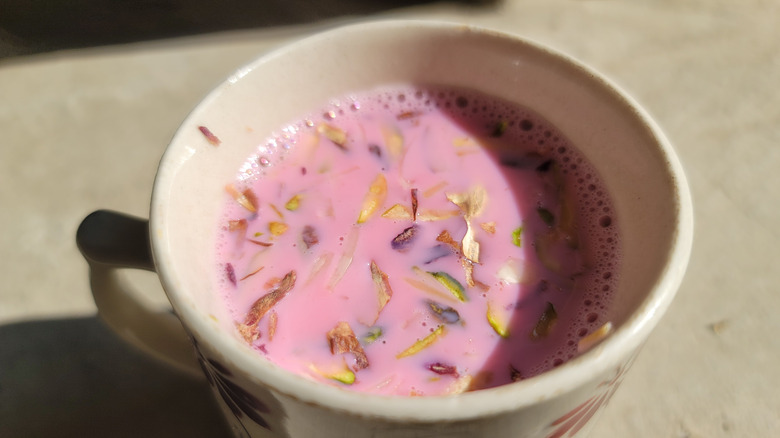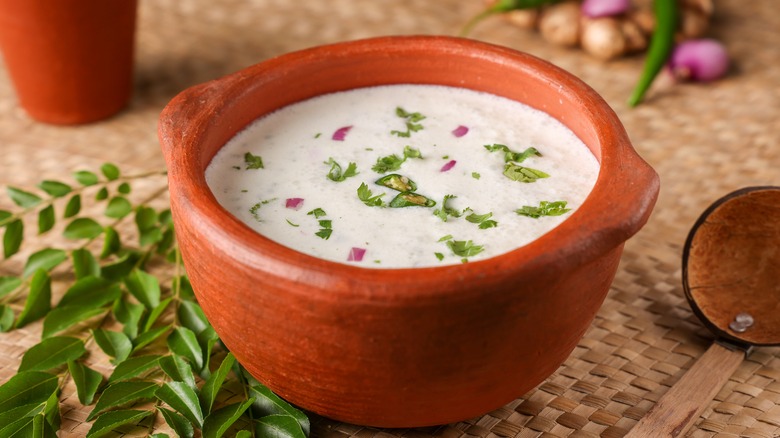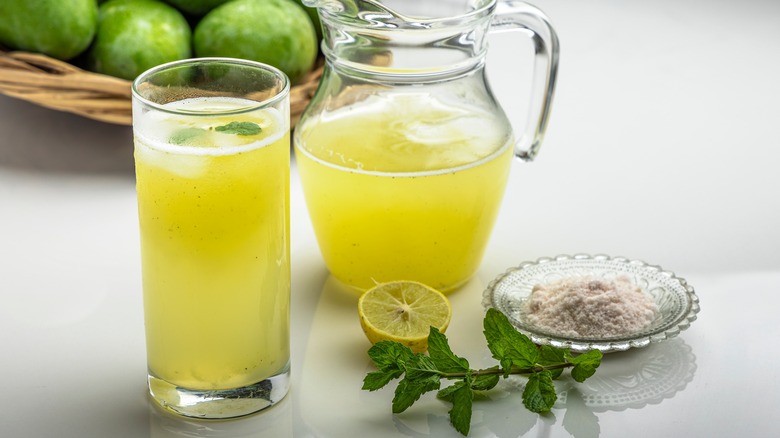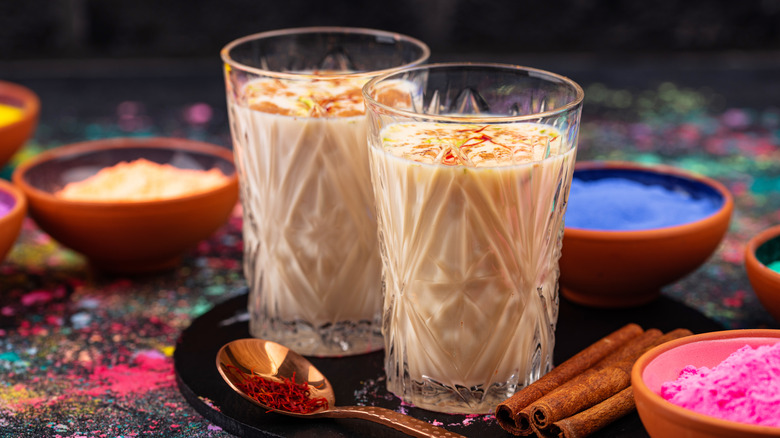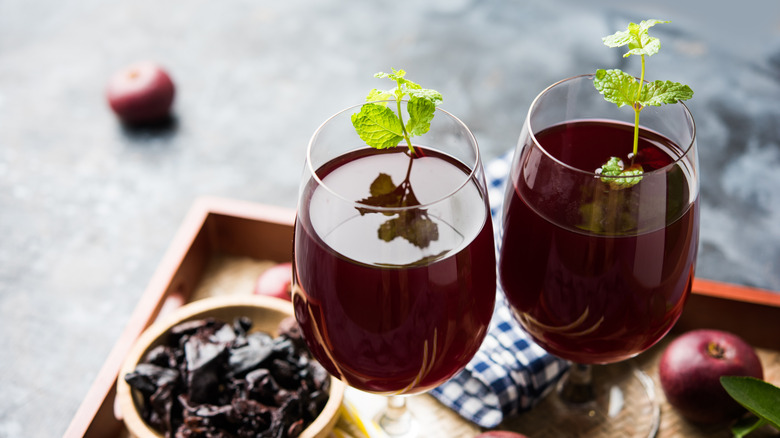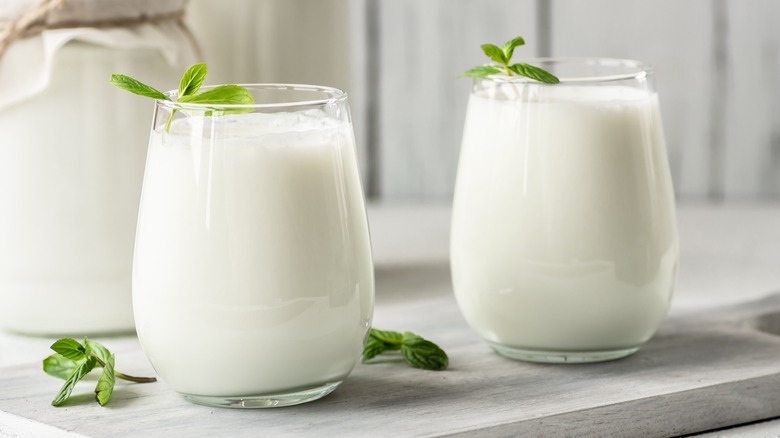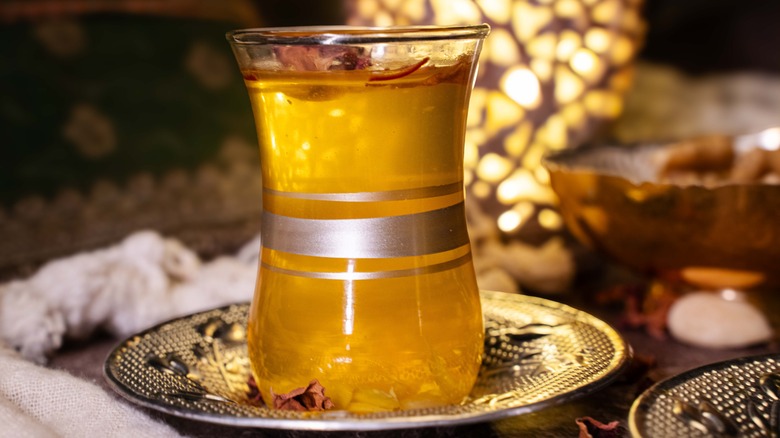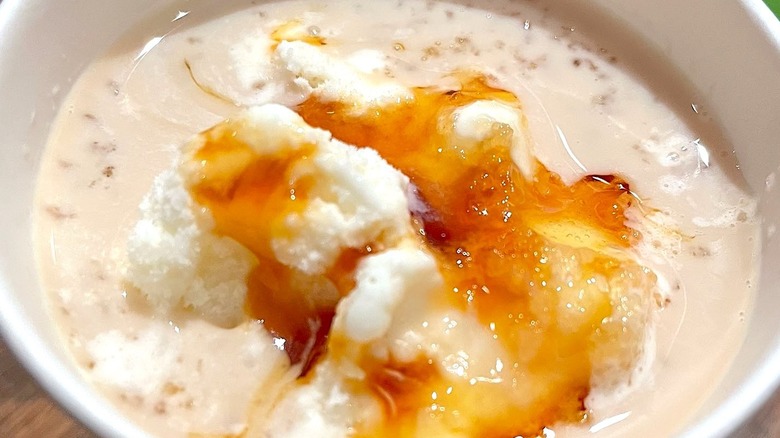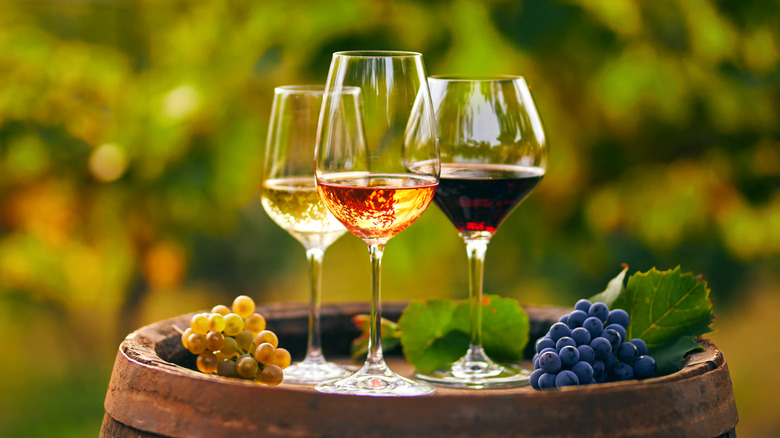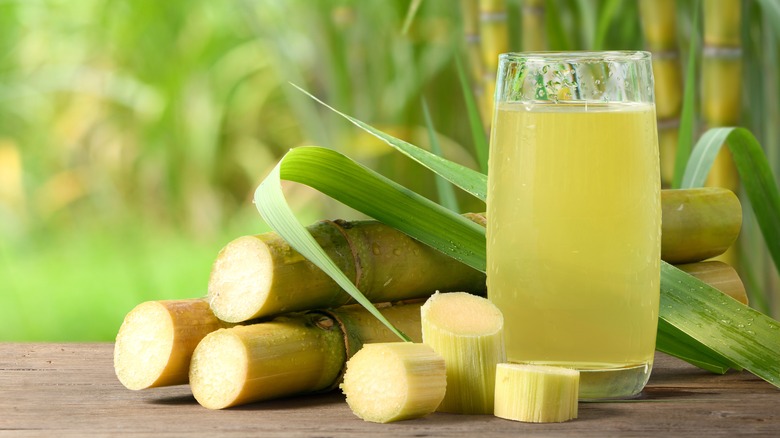21 Indian Drinks You Need To Try At Least Once
Indian cuisine is lauded by foodies worldwide for its unrivaled diversity of regional dishes, each boasting a layered palate of rich, intense flavors. Despite being a beloved cuisine seemingly all over the world, there's little love or attention for the countless beverages famous in India. Let's change that.
I've spent over a decade of my life cooking Indian cuisine, plus five years actively developing and publishing Indian recipes for a global audience. Perhaps more importantly, I've dedicated most of my adult life to researching and unearthing ultra-regional, authentic recipes that haven't yet gained national recognition, let alone global, yet unequivocally deserve a place in the global consciousness.
I'll delve beyond the chai tea latte and open your eyes to the seemingly endless variety of traditional (and modern) Indian drinks. From oak-aged wines from the verdant valleys of Maharashtra, to juices from near-extinct fruits, India has an impressive array of beverages worth sampling.
Solkadhi
You've likely never heard of solkadhi, a vibrant pink-colored drink that accompanies all meals in the Konkan region during the blistering heat of Indian summer. The drink's distinctive hue comes from kokum, a unique sweet and sour fruit from the mangosteen family. According to Ayurvedic tradition, kokum has a cooling effect on the body, hence the designation of solkadhi as a summer special. The addition of creamy milk from young coconuts only amplifies the refreshing effect.
Solkadhi is anything but plain. It's seasoned with numerous spices, including lemony cilantro, warm and earthy cumin powder, fiery chiles, ginger, garlic, and black salt, all of which give it an incomparable flavor. The nuanced notes of sweet fragrance, subtle spice, tanginess, and nuttiness makes it a must-try for anyone who loves complex drink mixes. Sip it the traditional way — as a pre-meal appetizer — or enjoy it as a digestive after your meal.
Masala chai
The U.S. is understandably obsessed with chai lattes and chai-spiced desserts. But most people overlook the root recipe: Indian masala chai. It's a hearty and comforting drink worth seeking.
In Hindi, chai directly translates to "tea" (so there's no need to say "chai tea"), while masala means "spices." Floral cardamom, cloves, punchy ginger, cinnamon, peppercorns, and warm nutmeg lend an unmistakable taste and aroma to the black tea leaves. Moreover, cane sugar or jaggery sweetens the drink, and plenty of fresh milk (buffalo milk is the go-to in India) makes it deliciously creamy. Many Indian tea lovers enjoy chai as a quintessential part of their daily routine, alongside cookies, cake rusk, savory breakfast dishes, or street-style snacks like pakora.
Nimbu pani
If you're a fan of lemonade, I've got the most phenomenal recommendation for you: nimbu pani. It's a citrusy drink loaded with summer flavors. Nimbu pani translates to "lemon water" (although lime is just as prevalent, since there's little distinction in Indian languages or cooking). The freshly squeezed citrus juice is just the beginning. To make the easy beverage, take a large pitcher and stir sugar, fresh mint leaves, roasted cumin powder, and the secret ingredient — a pinch of sulphuric black salt — into the zesty, tart juice. Dilute with water (or soda, for a nice kick) and serve over ice.
As with most drinks, there's room for experimentation. Some chefs add lip-smacking savoriness with chaat masala, a spice mixture packed with bold piquancy. Others amplify the lemony character with a sprinkle of coriander powder or freshly cracked black pepper for an unexpected, but pleasant, heat.
Piyush
Piyush, a relatively modern beverage invention, is a summer favorite in Maharashtra. It uses one of the state's most in-demand desserts, shrikhand, a sweetened thick yogurt flavored with cardamom, saffron, and nuts, as the starting point. Then, it builds on the flavors with added creamy milk and buttery, sharp chaas (plain buttermilk).
While there may only be three primary ingredients in piyush (extra nutmeg and ground cardamom build on the warm essence, and pistachios to garnish the glass are a must), its flavor is quite complex. There's a luxurious sweetness with light touches of floral spice and barely noticeable astringency. Sipping the thick, smooth beverage is an unmissable experience, so if you see piyush on a menu, be sure to snatch it up.
Kanji
Gone are the days of kefir and kombucha being relegated to health food stores. In recent years, the importance of gut health has brought probiotic foods and drinks to the limelight. We're all about the punchy flavors of classic Korean kimchi and buying tempeh has never seemed easier. In India, you can drink your probiotics in a satisfyingly tasty way, thanks to kanji.
This beverage, hailing from Punjab, showcases red or purple carrots fermented in water with mustard paste, black salt, and a hint of fiery red chili powder. After a few days, the carrots can be enjoyed like pickles and the resulting liquid will boast a salty, tangy, and slightly sweet flavor.
Want to make kanji at home, but heirloom carrots aren't accessible? No problem. Some home cooks combine ordinary orange carrots with beetroot to achieve the same eye-catching cerise color. It's commonly served with vada (lentil dumplings).
Haldi doodh (turmeric milk)
Whether you call it turmeric milk, golden milk, or the authentic name, haldi doodh — this is your sign to grab a saucepan, milk, some spices, and your favorite mug. In the late 2010s, turmeric milk was seemingly inescapable. Everyone was getting in on the trend; Starbucks sold turmeric milk lattes while turmeric-infused, energy-boosting wellness shots from the up-market Erewhon were flying off the shelves. Cuddling up under a blanket and sipping on a cup of hot, sweet, and slightly peppery turmeric milk evokes an undoubtable feeling of coziness.
In India, though, haldi doodh (meaning "turmeric milk") is much more than a cursory fad. Rather, the beverage has been part of the culture for centuries, likely originating from Aryuveda. Compared to the vanilla-infused golden milk of the West, the original version is simple and homely; it only consists of turmeric dissolved in hot milk. If you're feeling fancy, you might try a dash of black pepper or a spoonful of honey.
Falooda
Somewhere between a dessert and a drink lies perfection. And when I say perfection, I mean falooda, a textured dessert beverage with a fascinating history. Today, Indian people associate the drink with irresistible ingredients like sweet basil seeds, rose-flavored jelly, vermicelli noodles, pink rose syrup, vanilla ice cream, milk, and chopped pistachios. It's creamy, floral, indulgent, and refreshing. In other words, falooda is a real treat.
However, most food historians suggest its origins lie far from India — specifically Persia. A sorbet-like dessert called faloodeh, featuring vermicelli and rose water, thrives in popularity in the region, which is now known as Iran. It seems likely that Mughal rule brought the dessert to South Asia, where it transformed into the iconic drink we know today.
Jaljeera
Restorative and thirst-quenching are the aptest descriptions of this robustly-flavored drink. Jaljeera — meaning "cumin water" in English — is considerably more delectable than it sounds. Its ingredients, including mint leaves, freshly soaked tamarind, cumin seeds, fennel, black peppercorns, zesty and fruity dried mango powder, smoky black cardamom, ginger, chaat masala, and an ample squeeze of lemon juice, help offer that characteristic earthy, spicy, and sour taste.
It's blended with ice-cold water, sieved, and poured into glasses, ready for you to savor. Interestingly, jaljeera isn't just a drink — it's essential for pani puri, one of India's most renowned street-food chaat dishes.
Filter coffee
Tea reigns supreme in much of Northern India, where plantations cover the rolling hills in a blanket of lush greenery. But in the Southern tip of the country, it's a different story. Travel there, and the aroma of freshly brewed filter coffee — known affectionately as filter kaapi — covers every street. The coffee trees grow in the rainforests of the Western Ghats and then make their way to large cities like Mysuru. Workers roast, then grind the beans into a bold, woodsy, and earthy powder. The coffee is sometimes mixed with chicory, a bitter, caffeine-free herb that elicits divisive responses among coffee drinkers.
For many, making filter kaapi is a treasured ceremony. The main distinction between Western coffee, apart from the beans (which have a spicy flavor similar to Indonesian coffee), is the brewing method; Indian filter coffee uses a unique stainless steel press that allows the coffee to filter for almost 50 minutes. This results in a considerably more robust flavor ideal for drinking alongside idli or vada.
Sweet lassi
Lassi is a staple of Indian cuisine. It's a beloved summer cooler, whipped up in homes and sold by roadside vendors, where it's served in traditional clay cups called kulhad. After drinking, patrons smash the cups and the clay is recycled. Meanwhile, further abroad, mango lassis are a staple on restaurant menus.
Lassis start with homemade yogurt for a creamy, thick base. Freshly pounded cardamom pods, sugar, and delicate saffron strands whisked in make the most basic version of the beverage. From there, additions, such as mango, banana, or strawberry, add fruity freshness. Moreover, rose lassi boasts a floral sweetness, while modern adaptations like rich chocolate lassi toe the line between East and West. Once you have the rudimentary recipe down pat, there's no end to the creative innovations possible.
Indian whisky
Here's a fact that might surprise even the most knowledgeable alcohol connoisseurs: India — a country where booze consumption is discouraged across a large swath of the population due to religious reasons — is one of the largest consumers of whisky globally. Ostensibly, Indian people developed an appetite for whisky after British colonists brought the liquor to the country in the 20th century.
Soon, India began distilling its whisky to suit the local tastes — which included infusing a distinctive fruity, malty, smoky flavor into the liquor. Some Indian brands use a high concentration of molasses, in turn augmenting the beverage's already deep, caramelized aftertaste. As a result, some Indian whisky isn't regarded as "real" by international standards.
Noon chai (Kashmiri pink tea)
Shockingly, this unique and beautiful beverage recipe from Kashmir — a beautiful Himalayan region home to some of the highest peaks in the world — doesn't use any artificial colors. Unlike the more familiar masala chai, Kashmiri pink tea (provincially known as noon chai) uses locally-grown green tea leaves. It does, however, share some similarities in flavoring with masala chai. Floral cardamom is a mainstay, and star anise and cinnamon can sometimes make an appearance.
However, here's where the divergence begins. Sea salt is essential to Kashmiri pink tea (noon means "salt" in Kashmiri), as is steeping the tea leaves for almost an hour. A pinch of baking soda sparks the magical transformation by igniting a chemical reaction with the tea leaves and turning the liquid rosy pink. It doesn't alter the taste, though — and you're left with a slightly salted, perfumed, milky tea that's a pleasure for the eyes and tastebuds.
Chaas
To say delicious buttermilk recipes are abundant is an understatement. However, next time you're wondering what to do with leftover buttermilk from your fried chicken or buttermilk pancakes, turn your attention to chaas, a traditional buttermilk drink tempered with spices.
Recipes vary vastly across the country, but always share the same tasting notes: peppery heat, grassy earthiness, and fresh, lip-puckering tartness. Mint, fresh cilantro, sharp black pepper, and toasted cumin powder are frequent additions to North Indian chaas. In South India, you're more likely to see fruity red chiles, zesty curry leaves, and pungent black mustard seeds tempered in oil then combined with the creamy, rich buttermilk. For a thoroughly authentic experience, try drinking chaas from a clay cup.
Aam panna
Millions of people across India wait in anticipation for mango season and the associated delights — aamras puri, lassi, and mango chutney, to name just a few. Before the season arrives, though, there's a different kind of mango to savor. Green or raw mangoes (kairi or kaccha aam) are sought-after for making pickles, souring curry and lentil dishes, and mixing drinks. Undoubtedly, the most widespread preparation is aam panna (also called panha), a sweet and tangy cooler with fruity, spicy overtones.
You likely won't find aam panna at Indian restaurants, but if you head to your local Asian store, you might be lucky enough to stumble upon the small green fruits and make some of your own. Fascinatingly, aam panna requires one to boil or roast the green mangoes before blending the pulp with fresh mint leaves, cumin powder, black salt, sugar, and ice water.
Thandai
One of the most notable Indian festivals is Holi, a Hindu celebration known globally as the Festival of Colors. It's name is a nod to the fun tradition of gathering together as a community and joyfully throwing colored water and powders at one another. Something we don't hear about as much, though, are the traditional food and drinks associated with Holi.
Notably, people go wild for thandai, which means "cooling" in Hindi. It's a thick and creamy drink worth traveling for. All you need is a fragrant, nutty masala paste made with soaked nuts (almonds, pistachios, and cashews), seeds (poppy, fennel, melon, and cardamom), gorgeously scented rose petals, peppercorns, and saffron. Add the paste to hot milk, allow it to infuse with the spices, and enjoy this beverage chilled.
Kokum sharbat
Grab a glass of kokum sharbat the next time you have the opportunity. Kokum, a fruit native to the Western shores of India, faces the threat of possible extinction in the next few years due to climate change, among other reasons — so it's critical to savor drinks like kokum sharbat while we still have the chance.
The invigorating, vividly colored beverage is made by soaking dried kokum fruit, blending it into a paste, then making a syrup by heating the mixture with sugar and aromatic spices. It tastes exceptionally tempting when topped up with chilled soda and ice.
Salted lassi
India is a land rich with spices, so makes sense why many of its drinks would make use of sweet, fruity, salty, and savory ingredients. Salted lassis, as the name suggests, integrate the latter two flavor profiles into a distinctive beverage.
Compared to its sweeter counterpart, salted lassi is less taxing to make, but it's far from plain-tasting. Yogurt is the base ingredient, and any lassi worth writing home about will use a creamy, unctuous variety. You can even try your hand at making homemade yogurt, since it's relatively easy to do and can alter the taste of the finished beverage entirely. The seasoning added marries salty and spicy — thanks to a pinch of smoky roasted cumin and penetrating black salt.
Kahwa
Masala chai is beloved across India. While the iconic recipe deserves the attention, it would be a mistake to overlook India's rich landscape of regional tea preparations, some of which rival the more well-renowned ones. Take Kashmiri kahwa (sometimes spelled "kahwah"), a relaxing and rejuvenating blend made from green tea leaves, cardamom, cinnamon, and cloves. Families often add their own ingredients and spin on the beverage; you may find recipes made with saffron and honey to create a golden hue, or ones that add almonds for a nutty richness.
Unfortunately, it's unlikely you'll find the brew in restaurants outside India. But in Kashmir, an area famed for hospitality, homes always have a handful of tea leaves and a tall copper kettle at the ready when unexpected guests come knocking.
Jigarthanda
Some beverages are well-known throughout India, from its northernmost to southernmost borders. Others, like jigarthanda, are hidden gems of specific states (in this case, Tamil Nadu). You're not likely to find this drink anywhere outside Tamil Nadu — which is precisely why I'm even more eager to recommend it. Head to Madurai, meander through the bustling streets, and you're likely to find a jigarthanda pushcart on every corner.
For the curious, jigarthanda is made of an uncommon collection of ingredients: creamy full-fat milk stirred with almond gum, sarsaparilla syrup (nannari), sugar, and cream. Sometimes, vendors add a scoop of ice cream or basundi (reduced milk with nuts). The result is a malty, creamy, cooling drink that lives up to its name, which translates to "that which cools the heart."
Indian wine
When selecting a bottle of wine, you might head straight to heritage labels from France, Spain, Italy, or perhaps California — but India also has a growing wine industry worth exploring. Especially memorable are wines produced in the fertile valleys of Nashik, the anointed "wine capital" of India. Classic gems like rosé, sauvignon blanc, pinot blanc, and red or white sparkling wines are all available, while surprising entries such as the light and citrusy Chenin blanc are said to marry beautifully with the hearty spiciness of Indian food.
If this all sounds very tantalizing, I've got excellent news. Many Indian wineries offer private tours of their vineyards, including an opportunity to book overnight stays in the lush landscape, dine on fine food, and taste some of the best Indian wines the country has to offer.
Sugarcane juice
You likely have sugarcane to thank for sweetness in your coffee or tea. The massive tropical grass is native to India (amongst other equatorial countries) and plays a vital role in local socioeconomic systems. Making sugarcane juice is one stage in the production cycle. After the grass is harvested, crushed, blended, and filtered (which is where you get sugarcane juice), it can be further processed to create granulated sugar. Walk through the streets of India in summer, and you'll see street vendors passing the sugarcane through a machine to create fresh, on-the-spot juice sold by the glass.
Moreover, despite the logical assumption that sugarcane juice would be overpoweringly sweet and decidedly lacking in nutrition, both traditional sources and modern studies have proved sugarcane juice has many benefits. It delivers a complex, mildly sweet yet earthy and vegetal taste, further heightened with popular add-ins such as ginger and lemon.

